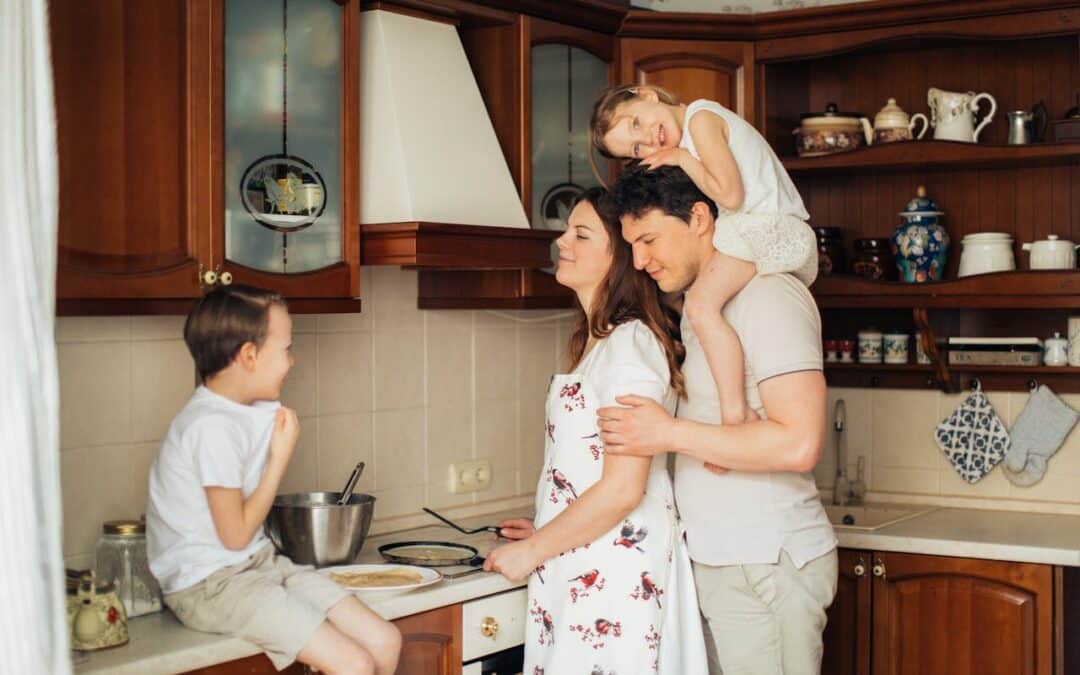From gingham aprons to Instagram-perfect sourdough, the “tradwife” trend is lighting up social media feeds—and stirring up serious debate. With millions of views on TikTok and Instagram, this old-fashioned ideal of womanhood is either being celebrated as empowering or slammed as harmful. But is there more to the movement than just pretty aesthetics and vintage homemaking?
In our latest piece, we go beyond the filters to talk with real women living traditional lifestyles today—all with a unique perspective. Is the tradwife label misunderstood? Is it dangerous… or deeply meaningful? Read Jena Johnson’s article and remember the quiet power of choosing home.
Faithfully for Families
Wendy Wixom, President
United Families International
Tradwives — Trend, Threat, or Timeless Truth
By Jena Johnson
From women dolled up in 1950s glam to homesteaders in flowy gingham, tradwives are trending—and everyone seems to have a different take on the movement. The term tradwife refers to a traditional wife who focuses on homemaking while supporting her husband as the primary income earner. Social media tradwives typically gain followers and create content with a certain aesthetic, often making their platform a part-time job.
On TikTok and Instagram, the hashtag #tradwife has amassed over 175 million views. It has become a somewhat demeaning label, putting down women who choose to stay home to raise children. But there is a lot of disagreement about what actually qualifies someone as a tradwife, which gender-specific roles or values are essential to claim that label, and whether the trend is harmful to young women and society—leading to plenty of debate and criticism about the trend.
While influencers with many followers, like Hannah Neeleman, Nara Smith, and Estee Williams, dominate the tradwife space on social media, other women are following suit. All over Instagram, I have seen women-run accounts about tradwife lifestyle. There are a few main questions people are asking. Is the tradwife movement dangerous or empowering? And beyond tripods and cameras, do tradwives really exist in this progressive era?
I reached out to several women—both those who identify as tradwives and those who align with more general pro-motherhood values—to get their thoughts about the trend and what traditional womanhood looks like outside the social media spotlight.This article dives into their thoughts as truly traditional wives and mothers as well as research and cultural conversations about the movement sweeping social media.
I interviewed Madeleine, a college-educated young wife and expectant mother, who shares a variety of content on her Instagram profile, which she says tends to shift with the seasons of her life. Madeleine openly embraces the tradwife label and finds joy in the roles she and her husband share as they build their life together. But she is no stranger to backlash. When the reel she posted—highlighting the acts of service she does for her husband—went viral, it brought a wave of harsh comments:
“So when you say “Trad Wife” you mean “Mother to a 30yo”🤔”
“Disturbing.”
“Eww. Just eww.”
“So you basically act like his mum 🤣🤣🤣🤣🤣”
“Sounds like you’re already taking care of one big baby.”
“More to life than being a baby making servant sis. But whatever 😂”
“******* gross…anyway she isn’t a trad wife she makes money…hope this helps”
“So what dose of lithium are you on?”
“This is disturbing.”
Other commenters came to her defense:
“Why is offering something nice to your husband strange?”
“This is very sweet. ❤️”
“Those are all basic acts of love, I’m not a trad wife and do all those things that’s normal when you care for someone.”
I asked how she deals with the criticism and she replied, “I like being a tradwife and I don’t care if I make people mad. But when people start coming after my husband or my baby, that’s where I draw the line.” After over 600 responses, she turned the comments off.
Criticism is not confined to Instagram comment sections. Perusing academic articles led me to biased analyses and over generalizations of tradwives. In a gross misrepresentation, one article painted all tradwives as women whose purpose is to advance a dangerous far right political agenda. Extreme arguments go as far as claiming that tradwives are pushing a white supremecist agenda and encouraging other white women to stay home and have as many babies as possible.
I spoke with Melissa, a mom of 9 who has been blogging in the online mom scene for over 20 years. She stayed home full-time to raise her kids, generating a part-time income from her blog and social media. Now that her kids are grown, she is a grandma and stay-at-home wife who continues to blog about traditional homemaking.
Melissa shared her thoughts on these accusations of tradwives pushing white supremacy.
“Sometimes more liberal biased writers will make those accusations just of Christians based on their belief that traditional families are the way God intended things to be. So I don’t know if that’s why they’re saying that, because I haven’t personally come across any extreme [tradwives]. When I am on social media, I do sometimes come across women who seem like they are on the extreme, but I’m also not sure how authentic [their content] is.”
The tradwife movement as a political movement?
Pointing to tradwives as dangerous political auxiliaries is a common and unfounded accusation that distracts from the real issue. In the tradwife discussion, it seems people solely focus on women’s liberation, introducing red herrings to demonize any female ambition other than boss babes climbing the corporate ladder. This idea gets pushed even at the expense of men and children’s well-being.
The fact that fathers and mothers each contribute crucially different skills has long been established. Traditional roles are key to partnership in marriage across cultures and religions worldwide. Women are desperately needed and valued as mothers to their children and wives to their husbands. Today, more options exist for women to enjoy the flexibility of balancing work and family life. However, modern feminism frowns on the self-sacrifice full time motherhood requires. By that premise, our self-serving culture would find the idea of stay-at-home motherhood threatening to women’s wellbeing.
I interviewed Rachel, also known as Conservative Momma, who spoke directly to this point. She shared,
“Our world is so ‘me’ focused, it’s all about you and putting yourself first. But there’s something extremely rewarding and fulfilling when you start to put other people before yourself. It teaches you more about yourself, actually. I would say if you want to know more about who you really are, and get a whole 360 panoramic view of the meaning of life and its purpose–be a mom.”
Rachel went to college to pursue acting and now shares her talents through political satire on Instagram. One aspect of her story I find delightful is that she credits her children for expanding her capacity to do what she loves as an actress as well as being their mother. After college, Rachel made it clear to her now-husband that being a stay-at-home mom was her top priority, but she is a wonderful example that women can still do what they love and pour their heart into child-raising. But she will be the first to acknowledge that it does require some sacrifice and flexibility.
“Having it all”
The undercurrents of the tradwife debate include this ideology that women can and should have it all—children and a full-time career with benefits—if they desire to. The promotion of the tradwife lifestyle “threatens” exposure to the reality that the have-it-all dream may be an illusion. As many say, “you may be able to ‘have it all,’ but not at the same time.” Cautionary tales of isolated, drugged-up 1950s housewives circulate the online conversation. But the “me-focused” feminist solution of today is not working either. In a debate with 20 feminists, Candace Owens touches on the fact that today women are binge drinking at higher rates than in the 1950s to cope with the stress of trying to “have it all”. She argues that women are not happier as a result of leaving the home and entering the workplace.
Similarly, Savannah shared with me her experience of trying to make herself fit into the hustling career-woman lifestyle. She explained that she always wanted to be a stay-at-home mom, but even as a teenager she recalled,
“I could feel the pressure from society to do something other than become a wife and mother. It was to pursue a career. I was very anxious and depressed about the future. I wasn’t sure what to do with my life so I decided to pursue a career as a police officer and I went to college for that for a while.”
Her life completely changed when she met her husband and fully embraced traditional wife and motherhood, generating the happiness and fulfillment she had been looking for. Savannah is now a homeschooling stay-at-home mom who loves to share her perspective and connect with like-minded women in her corner of social media.
I generally believe the arguments against women choosing to be tradwives and finding fulfillment in raising their families are unreasonable. However, it is worth noting some of the concerns about the influencer tradwife lifestyle, particularly from the perspective of boots-on-the-ground moms.
Melissa wonders whether influencer tradwives truly place their family as their highest priority, which is what a wife in the traditional sense would do.
“Often my suspicion is if the persona has become so important to this woman that her family is secondary to the aesthetic. And that concerns me. Like I said, I don’t know any of these women personally. But that’s what I have wondered. Is this healthy? Is the family feeling so much pressure to stay perfect all the time? In real life, there is no such thing as a perfect family.”
Rachel also commented on the drawbacks of the tradwife trend,
“Sometimes it can be glamorized into something that’s not necessarily true. You see the woman in the beautiful sundress milking a cow…like really? I got my milk at the local grocery store. Nothing is as glamorous as what social media often presents. It’s real life. Embracing real life is a healthy thing to do, there’s positives, there’s negatives.”
Melissa’s observation wraps it all up nicely: “Anytime you take anything to the extreme, there’s going to be problems. And once you do it’s no longer healthy.”
Some conclusions on the “tradwife” movement
After doing lots of research and speaking with these educated, compassionate, and articulate women, I’ve come to view the tradwife trend as a movement with both surface-level glamor and deeper meaning. What lies beneath the trend—the desire for purpose, family, and a return to certain values—is meaningful and empowering, not to women alone but benefiting all of society through strong family relationships. Critics may argue that embracing traditional womanhood undermines modern women’s rights, but the experiences of women like Madeliene, Melissa, Rachel, and Savannah tell a different story.
Traditional womanhood doesn’t have to be a one-size-fits-all ideal. For some, it may look like full-time homemaking and homeschooling. For others, it may be more of a balance of different responsibilities both in and out of the home.
We should all be well aware by now of the perfect lighting, angles, and editing that create the seemingly flawless trends on social media—and be careful not to take that aspect too seriously. But beyond the trend, something society is bringing renewed awareness to, are wives and mothers who are deeply fulfilled in their traditional responsibilities. These women are deeply needed in today’s society and should feel celebrated and proud to embrace that lifestyle.
 Jena is a senior at BYU-Idaho and will graduate in December 2025 with a degree in Marriage and Family Studies specializing in family advocacy. She and her husband live in Utah and are expecting a baby girl. Together, they love to travel, read, cook, and hike. After graduation, Jena plans to put her career on a brief hold to be a stay-at-home mom and later pursue a Master’s degree in Marriage and Family Therapy.
Jena is a senior at BYU-Idaho and will graduate in December 2025 with a degree in Marriage and Family Studies specializing in family advocacy. She and her husband live in Utah and are expecting a baby girl. Together, they love to travel, read, cook, and hike. After graduation, Jena plans to put her career on a brief hold to be a stay-at-home mom and later pursue a Master’s degree in Marriage and Family Therapy.

